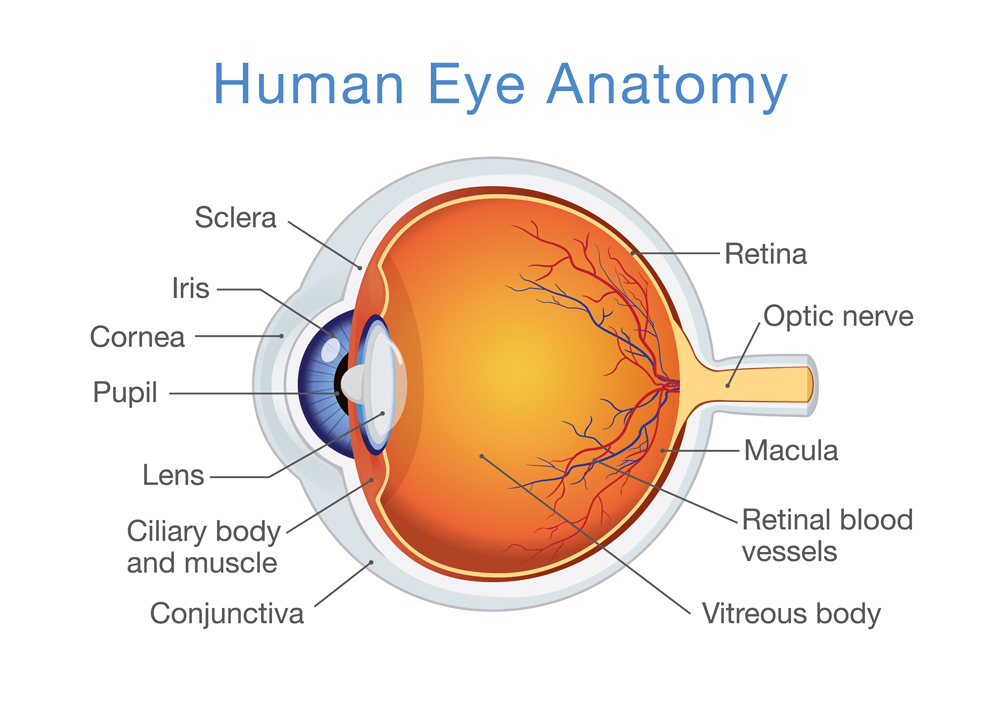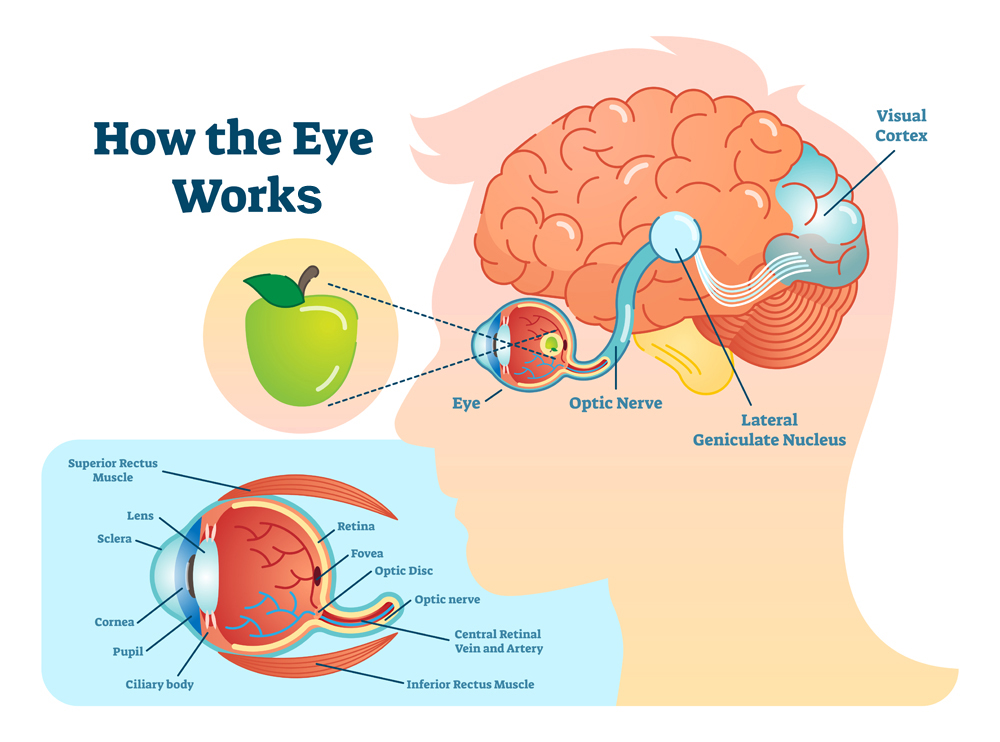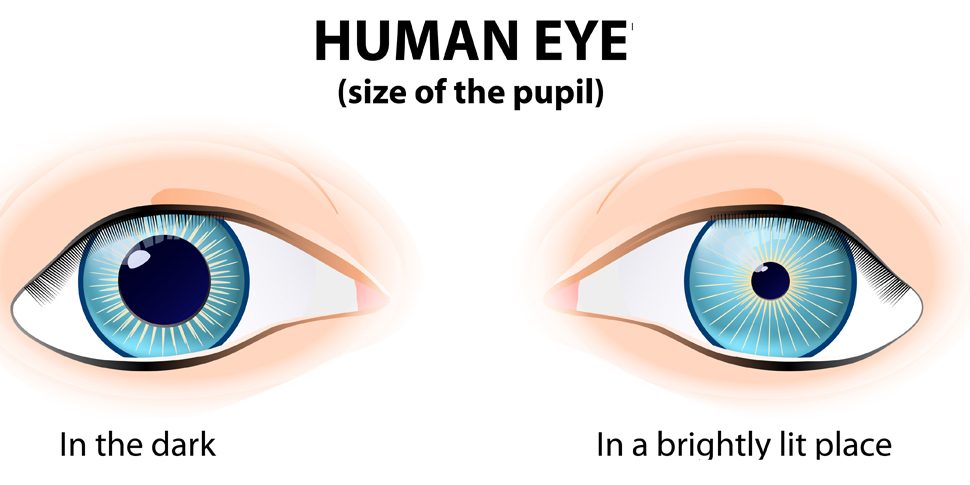Table of Contents (click to expand)
The pupillary light reflex is a reflex that controls the diameter of the pupil when it is exposed to varying intensities of light. This allows the eyes to adjust in response to bright or dim lights.
Walk into any room and switch on the light; everything seems perfectly in its place. Now, switch off the light and try to see what is in the room. Give yourself a bit of time and you’ll be amazed at how clearly you can still able identify various items in the space. Although you may not be able to see them as perfectly as before, you can still see well enough so you won’t trip in the dark!
The manner in which your eyes are able to adapt to the lighting and allow you to see in the dark is fascinating! The eye is a beautiful part of the body that helps us see marvelous images from the world around us. The pupil is able to adjust to light in the surroundings, allowing us to see in both light and dark environments. The pupillary light reflex is the reflex that controls the diameter of the pupil when it is exposed to varying intensities of light.
How Does The Eye Work?
Vision is a complex process that involves the coordinated and simultaneous activity of the brain and the eye. The light entering the eye gets converted to an electrical response called a nerve impulse. These nerve impulses travel to the brain along the optic nerve in order to create the final image. The optic nerve is the nerve that transmits visual information from the eye to the brain.
To better understand how light travels from the retina to the brain, let’s take a closer look at the eye!
The most important parts of the eye include the iris, the cornea, the lens and the retina. Each of these plays an indispensable role for us to see a clear image. The eye or the eyeball is located in the eye socket, but we can only see the front part of the eye.

The white part of the eye is the sclera, which is the visible section of the outer layer of the eyeball. The colored part of the eye is the iris, which has a small disc-like shape with a hole in it called the pupil. The pupil is black, as almost no light can escape from it. It is the pupil that either contracts or dilates, depending on the amount of light that reaches it. A transparent layer called the cornea covers the iris and the pupil. The cornea is like a dome around the iris and behind the cornea is a fluid called the aqueous humor, which helps to cleanse the eye and provide the required nutrients to the eye. The cornea also protects the eye from foreign particles and injury. Our eyelids and eyelashes serve the same function, although many people (myself included) probably wish there was something to prevent eyelashes from entering the eye!
The eye has 2 other very important components—the lens and the retina. The lens is attached to muscles with the help of strong fibers. The contraction of these muscles will change the shape of the lens. Light rays that pass through the pupil reach the lens located behind it. The role of the lens is to focus the light on the retina. The path of light that enters the eye changes (refracts) to different extents, depending on the shape of the object. Refraction occurs when light enters different mediums. In the eye, light travels from air into a liquid-like medium of the cornea, which causes a change in its pathway. The process of change in the pathway of light is called accommodation and it allows the eye to focus on objects located either close by or far away.
The retina is the innermost tissue of the eye and is a light-sensitive portion of our visual system. The retina contains millions of sensory cells, including light-sensing cells called photoreceptor cells, which are designated as either rods or cones. Rods function in dim light and provide the contrast of black-and-white vision, whereas cones function in well-lit environments and are able to perceive different colors.
The refraction caused by the lens creates a sharp image on the retina. The sensory cells present on the retina receive these light signals and transmit them to the brain via the optic nerve.

The main role of the optic nerve is to transfer visual information from the retina to the vision centers of the brain with the help of electrical impulses. The optic nerve is made up of nerve cells and is a critical part of the central nervous system.
In simple terms, the nerve signals from the rods and cones are sent to the brain via the optic nerve. Inside the brain, these signals are converted to create the images that we see.
Also Read: Why Do Radiologists And Pilots Wear Red Goggles In Bright Light?
How Does The Eye Respond To Light?
Up to this point, we’ve discussed how light enters the eye and travels to the brain via the optic nerve to create the final image. Now, let’s further discuss how the eye responds to different intensities of light, which is closely related to the processes explained above.
I recently went to my best friend’s wedding and seeing the newly married couple made my heart fill with joy. At that moment, I took two pictures—one with the help of a digital camera, while the other was a “mental picture”. Basically, I focused my gaze on a scene, in the hopes that my brain would stored that particular image, just like on a regular memory card. Interestingly, the eye functions much like a camera, adjusting the light that enters the pupil so that we get a perfect image.
When the light entering the eye is too bright, the pupil constricts or shrinks, allowing less light to enter the eye. When you point a bright light directly at your eye, you can observe how swiftly the pupil constricts—almost instantaneously. The pupils constrict as a way of protecting the retina from dangerously bright lights.

At the other extreme, when you enter in dimly lit area, the pupil dilates or expands, allowing for more light to enter the eye. In fact, dilated pupils are often seen as a sign of beauty, which is one of the reasons why candle-lit dinners are often linked with romance!
Also Read: Pupil Dilation: Why Do Pupils Dilate?
How Are We Able To See In The Dark?
The main players in vision are the rods and cones. The rods are extremely efficient in dim light, as even a small amount of light is able to trigger them. They are able to accurately detect light, contrast and movement, but they’re unable to identify color.
The pupil dilates as a result of low light and allows as much light as possible to enter the eye. This light then reaches the retina and the rods convert the light energy to electrical energy, with the help of the optic nerve, to produce the final image. There’s one major difference; given that the rods are unable to identify color, the image seen in low or dim light is always in black and white.

The pupillary light reflex is a very unique and interesting way that the eye captures images and manages light exposure. Almost like a camera, the eye adjusts the amount of light that enters to create the perfect setting; this leads to the formation of an image by the brain. However, the next time you take a picture with a camera, remember to manually adjust the aperture for perfect lighting, as the pupillary reflex is a specialty of the eye alone!
How well do you understand the article above!

References (click to expand)
- Ellis, C. J. (1981, November 1). The pupillary light reflex in normal subjects. British Journal of Ophthalmology. BMJ.
- McCaa, C. S. (1982, April). The eye and visual nervous system: anatomy, physiology and toxicology. Environmental Health Perspectives. Environmental Health Perspectives.
- Unlocking the Mystery of How the Brain Creates Vision. Scientific American
- How does the eye work? - InformedHealth.org - NCBI Bookshelf. The National Center for Biotechnology Information
